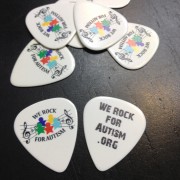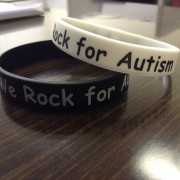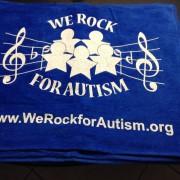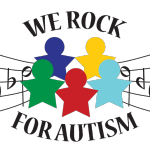What is Music Therapy and How Can it Help an Individual with Autism?
Sign Up for our Monthly Newsletter
Upcoming Events
80s in the Park 2016
LOCATION: 625 E Hibiscus Blvd, Melbourne, FL 32901
START DATE: August 25th, 2016
Products
-
 Guitar Picks
$2.49
Guitar Picks
$2.49 -
 Black and White Bracelets (2 pk)
$5.99
Black and White Bracelets (2 pk)
$5.99 -
 Rally Towels
$5.99
Rally Towels
$5.99 -
 We Rock for Autism Blue Bracelets (2pack)
$5.99
We Rock for Autism Blue Bracelets (2pack)
$5.99
What is Music Therapy and How Can it Help an Individual with Autism?
by Allison Lockhart, MT-BC
A music therapist walks into an elevator carrying a load of instruments. An individual in the elevator eyes the instruments curiously and asks, “What are you lugging around all those instruments for?” The music therapist responds by saying, “I’m a music therapist and I’m providing music therapy services here today.” The individual furrows their brow and says, “Hmm music therapy, that sounds interesting. I’ve never heard of that before….what is it?” The music therapist, knowing this question was coming, mentally chuckles and then smiles, ready and happy to respond.
This is the age-old question asked to music therapists. Music Therapy is a growing profession, and within the past few years it has been gaining more and more national recognition through television, movies, news, online media, and social network cites. However, most media sources do not fully portray music therapy accurately or they only show a small part of the picture. So the question still lies: What REALLY is music therapy?
Simply put, music therapy is a research and evidence-based practice that uses music interventions to reach non-musical, individualized goals. Such individualized goals can address and enhance behavior, communication, socialization, emotional expression, physical/motor rehabilitation, sensory integration, and academic/cognitive functioning. A music therapist assesses an individual and develops a treatment plan that tailors music interventions to a client’s abilities, needs, and preferences (including musical preferences). While working with a client, the therapist documents responses and progress towards target goals. It is a process of ongoing evaluation where the therapist modifies goals during review periods in order to keep goals current with client’s needs and maximize client’s potential.
But how can music therapy specifically help an individual on the autism spectrum? The American Music Therapy Association states that the music therapist “integrates a variety of ASD-specific evidence-based strategies (e.g., prompting, reinforcement, picture schedule) and music therapy techniques (e.g., singing/vocalization, instrument play, movement/dance, musical improvisation, songwriting/ composition, listening to music, or computer based music activities)” in order to provide a client with “intentional and developmentally sound music experiences.” This is important from a therapeutic standpoint; however, you may still be asking yourself: Why music therapy for individuals on the autism spectrum? I will answer this question in four parts:
1.) Music is structured and predictable
The wonderful thing about music therapy for individuals with autism is that research shows that individuals with Autism Spectrum Disorder are many times inclined with heightened musical aptitude and sensitivity to musical elements (Heaton, 2005). While not all individuals with autism are musical savants, all can benefit from music therapy services. Music by nature is engaging, accessible, structured, predictable, and consistent. These are all qualities that are many times important to individuals with autism. Music therapy sessions build upon and enhance these qualities resulting in a type of therapy that is very in tune to the learning needs of an individual on the spectrum. Simply put: structure + predictability = less stress= brain being able to process information.
2.) It organizes the brain
Music is also one of the few natural ways to target the brain stem. What does that mean exactly? Well when an individual with autism is having sensory integration issues, it can be nearly impossible for them to intake and learn new information. These sensory integration issues can include the individual experiencing overstimulation or craving a certain sensory input. You may notice individuals with autism sometimes jumping, trying to squish themselves between objects, or covering their ears. These can all be signs of a sensory integration issue. This sensory need is the number one priority before the individual can process any new sensory information around them and before any learning can take place. The way to fulfill this need is through providing the necessary stimulation to the brainstem. Music and repetitive rhythm, along with actually sensory input (e.g. bouncing the individual on a therapy ball or using lap pads), are the ways to get through to the brainstem. This opens the door to endless possibilities when teaching individuals with autism concepts through music.
3.) It increases connections in the brain
Music continues to provide benefits to the brains of individuals on the spectrum by increasing dopamine levels. In fact, music is one of the few natural dopamine enhancers. Again, why is this important for an individual with autism? While we don’t know the cause of autism, we know that it is very neurologically based and that individuals with ASD tend to have trouble communicating between different parts of the brain. Dopamine increases connections in the brain, thus helping these individuals’ bridge gaps.
4.) It engages the whole brain
Music engages the WHOLE brain. It is not just located in one hemisphere or section; it is present everywhere. That makes it a great tool to improve areas such as speech. Sometimes an individual with autism may have difficulties speaking due to lack of development in the verbalization areas of the brain. Yet this individual may still be able to sing because singing engages the whole brain, and thus engages areas of the individuals brain that are more developed. Through singing, the music therapist can help improve an individual’s speech with the goal being to eventually fade out the singing and have the individual just speak.
These are just some of the ways that music therapy can help individuals on the spectrum. Music therapy opens up many possibilities and is becoming a highly sought out therapy for individuals with ASD. It is important to touch on where to seek out a music therapist if you are interested in services. First, it’s important to find a Board Certified Music Therapist. A music therapist must complete an approved music therapy collegiate program, and receive board certification in order to be qualified to practice. We Rock for Autism has partnered with the Cadenza Music Therapy Center in Hollywood, FL, along with myself, a private practitioner serving areas from West Palm Beach through Miami, to help provide individuals on the spectrum in South Florida with quality music therapy services. However, if you are not in these areas you can visit the American Music Therapy Association’s (AMTA) website: www.musictherapy.org and search in the online directory to find a certified music therapist in your area. You can also contact the AMTA national office for more information ([email protected]; (301) 589-3300).
Look for future articles discussing specific ways music therapy is used to address sensory, social, behavioral, communication, cognitive, and physical/motor goals, a long with ways you can use music with a child with autism outside of the music therapy setting in places like your home.
Allison Lockhart is a board certified music therapist. To inquire about services or for more information, you can contact her at [email protected]
Posted by We Rock for Autism on Friday, September 18th, 2015 @ 6:00PM
Categories: News




